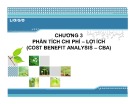
HPU2. Nat. Sci. Tech. Vol 04, issue 01 (2025), 48-59.
HPU2 Journal of Sciences:
Natural Sciences and Technology
Journal homepage: https://sj.hpu2.edu.vn
Article type: Research article
Received date: 08-01-2025; Revised date: 03-3-2025; Accepted date: 26-3-2025
This is licensed under the CC BY-NC 4.0
48
Cost-benefit analysis: utilizing mathematics to optimize economic
project decisions
Thanh-Xuan Cao Thi
*
University of Economics - Technology for Industrie, Hanoi, Vietnam
Abstract
Cost-Benefit Analysis (CBA) is an essential tool for economic decision-making, providing a systematic
way to evaluate the financial value of projects. It employs mathematical techniques to quantify benefits
and costs, enabling decision-makers to compare various options. By translating potential gains and
expenses into monetary values, CBA identifies projects that yield the highest net benefits. This method
allows decision-makers to assess investment feasibility, optimize resource allocation, and prioritize
projects based on their economic efficiency. The article emphasizes the importance of mathematical
techniques in enhancing informed decision-making during project evaluations. It illustrates how Cost-
Benefit Analysis (CBA) contributes to effective economic planning and resource management. By
providing a structured framework to quantify benefits and costs, CBA helps decision-makers assess
investment feasibility and prioritize projects. This ensures optimal resource allocation and maximizes
net benefits, ultimately guiding stakeholders toward economically efficient choices.
Keywords: economic, decision, mathematical techniques, benefits, costs
1. Introduction
Cost-Benefit Analysis (CBA) is an essential tool used in economic decision-making to evaluate the
feasibility and impact of projects. By systematically comparing the costs and benefits associated with a
project, CBA helps policymakers and business leaders make informed decisions that maximize value.
This process is particularly vital in the public sector, where resources are often limited, and the need for
efficient allocation is paramount. The precision and rigor provided by CBA ensure that investments
yield the highest possible returns in terms of economic, social, and environmental benefits [1][3].
*
Corresponding author, E-mail: cttxuan@uneti.edu.vn
https://doi.org/10.56764/hpu2.jos.2024.4.1.48-59

























